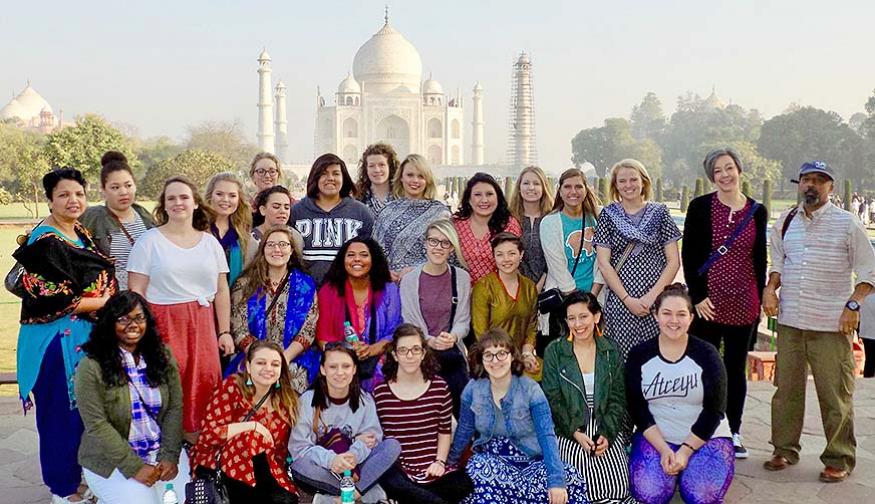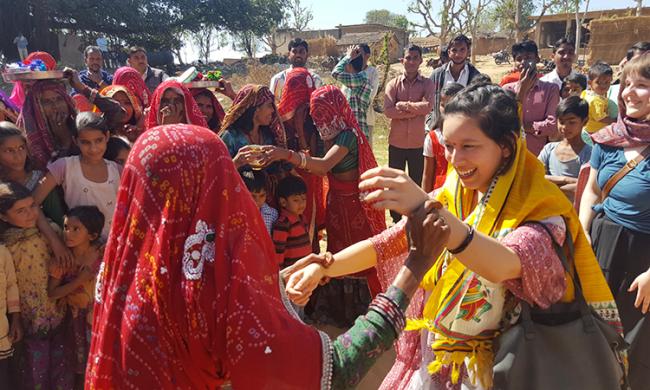
Learning from women activists in India
By Allison Blaisdell ’18
Spending spring break in India with the women’s and gender studies department was never part of my planned curriculum in accounting. But once I got the itch to apply for the program, I began to truly understand the value of a liberal arts education.
This term brought together the literature I studied in my first-year Foundations honors courses, the beauty I found in a Non-Western Art History perspective course, and pieces from other classes that piqued my interest along the way. I was grateful to have the support of my major advisors—and funding from Augie Choice—to encourage me in developing as a global citizen and activist.
Dr. Al-Wazedi and Dr. Popple carefully crafted a three-part program for us to learn to see globally and act locally. It began with a winter-term course, where we took an in-depth look at the issues Indian women struggle with, and the programs they have developed to empower themselves. We studied topics ranging from public health to marriage, education and the environment, and prepared to engage with local activists on the ground.
Next we traveled to the opposite side of the world—India’s Golden Triangle: Delhi, Agra and Jaipur.
Experiencing the flow of Delhi
After 30 hours’ travel, we landed in the capital of Delhi, home to over 18 million people. The hardest initial adjustment was the overwhelming population. (New York City has around 8.5 million.) From the minute we left the airport, however, we could feel the flow of the city. Roundabouts keep traffic rolling and the locals move about seamlessly in the crowded streets.
We saw everything from India Gate to the Presidential Palace and Gurudwara Bangla Sahib. We could easily have spent the entire trip exploring New Delhi!
Building and rebuilding in Agra
Our next stop was Agra. We were welcomed by a local cafe, Sheroe’s, run by and for survivors of acid attacks as they begin rebuilding their lives. Acid attacks are an unfortunate occurrence in South Asia. Despite recent legislation, the chemicals have a variety of household uses and are easy to come by. Often the attacks are committed by a man or his family against a wife who is unable to fulfill childbearing expectations. Resulting scars often force victims into a life of hiding, but Sheroe’s exists to change that narrative by ending attacks and reintroducing survivors into society.
We also could not visit Agra without a sunrise visit to the Taj Mahal. There simply aren’t words to describe the experience. Every inch of the property was carefully designed with precious stones from all across Asia to highlight the grandeur of Shan Jahan’s love for his favorite wife.
After touring the equally immaculate Agra Fort and stopping for dinner at a roadside oasis, we were on our way to Jaipur.
Learning from the locals in Jaipur
Jaipur was the most meaningful for me, because it was not intended for tourism: Jaipur was a beautiful example of our purpose in learning from the locals.
We spent time with local families during homestays. We attended guest lectures at the University of Rajasthan, and toured the world-renowned Jaipur Foot prosthetic limb factory. We also visited a local commune of performing artists who travel the world to showcase their acts at weddings and other celebrations. Some of the women helped us practice the techniques they use to create performance costumes, and others shared the joy and artistry of their dances.
We also traveled to a nearby village with a rich history of successful microcredit. Microfinance is a growing phenomenon in rural societies, in which group members pool their savings and make loans to those in community for things like medical expenses, business ventures or education. The sense of community not only reduces the likelihood of default, but also provides a social platform for the women to come together and spark change.

Acting on our observations
In the blink of an eye, we were back in Delhi preparing for the long trip to the United States. Our last bittersweet outing included getting souvenirs and henna from the craftspeople at Delhi Haat. The bright colors and high quality of handmade fabrics were unlike anything I have ever seen. Shopping and haggling in the markets is an experience as unique as the vibrant patterns.
Upon return, the third and final part the program is a one-credit spring-term course, and turning our observations into action. We will apply empowerment methods we learned to local non-profits that face many of the same issues.
I returned to campus inspired to utilize what I learned in my everyday life, my education and my career. I also gained a group of college friends from diverse backgrounds that I likely would not have crossed paths with, if not for traveling together to India.
